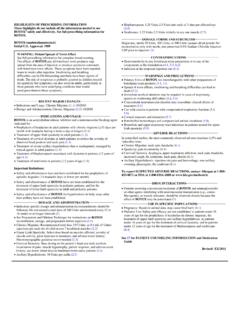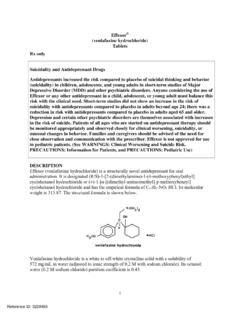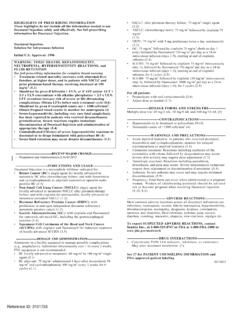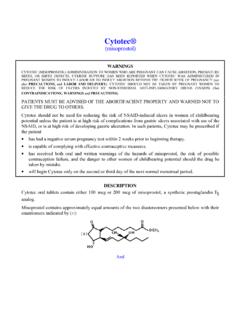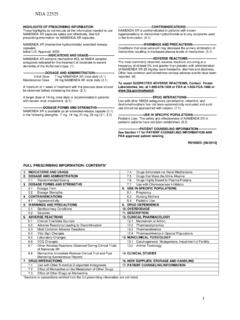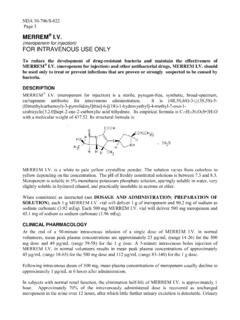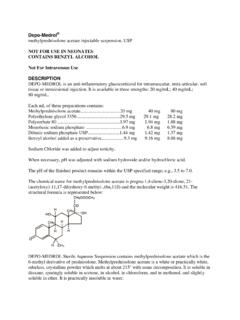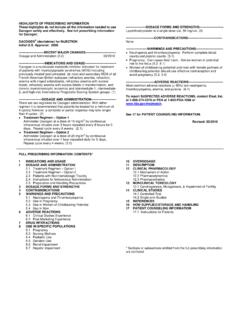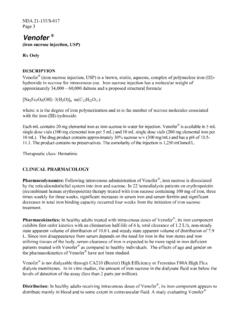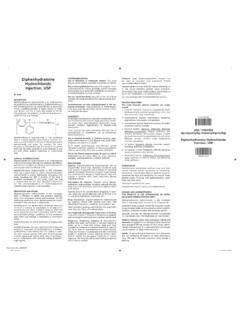Transcription of Cardizem CD (diltiazem hydrochloride) capsule label
1 N20062/S-040 Page 2 Cardizem CD ( diltiazem HCl) Capsules Rx only DESCRIPTION Cardizem ( diltiazem hydrochloride ) is a calcium ion cellular influx inhibitor (slow channel blocker or calcium antagonist). Chemically, diltiazem hydrochloride is 1,5-Benzothiazepin 4(5H)-one, 3-(acetyloxy)-5-[2-(dimethylamino)ethyl] -2, 3-dihydro-2-(4-methoxyphenyl)-, monohydrochloride,(+)-cis-. The chemical structure is: diltiazem hydrochloride is a white to off-white crystalline powder with a bitter taste. It is soluble in water, methanol, and chloroform. It has a molecular weight of Cardizem CD is formulated as a once-a-day extended-release capsule containing 120 mg, 180 mg, 240 mg, 300 mg, or 360 mg diltiazem hydrochloride .
2 The 120 mg, 180 mg, 240 mg, and 300 mg capsules also contain: acetyl tributyl citrate, ammonio methacrylate copolymer dispersion, black iron oxide (300 mg), castor oil, ethylcellulose, FD&C Blue #1, fumaric acid, gelatin, silicon dioxide, simethicone, starch, stearic acid, sucrose, talc, titanium dioxide and white wax. The 360 mg capsule also contains: acetyl tributyl citrate, ammonio methacrylate copolymer dispersion, diethyl phthalate, FD&C Blue #1, gelatin, povidone, simethicone, sodium lauryl sulfate, starch, sucrose, talc and titanium dioxide. For oral administration. CLINICAL PHARMACOLOGY The therapeutic effects of Cardizem CD are believed to be related to its ability to inhibit the cellular influx of calcium ions during membrane depolarization of cardiac and vascular smooth muscle.
3 Mechanisms of Action Hypertension. Cardizem CD produces its antihypertensive effect primarily by relaxation of vascular smooth muscle and the resultant decrease in peripheral vascular resistance. The magnitude of blood pressure reduction is related to the degree of hypertension; thus hypertensive Reference ID: 2867302 N20062/S-040 Page 3 individuals experience an antihypertensive effect, whereas there is only a modest fall in blood pressure in normotensives. Angina. Cardizem CD has been shown to produce increases in exercise tolerance, probably due to its ability to reduce myocardial oxygen demand. This is accomplished via reductions in heart rate and systemic blood pressure at submaximal and maximal work loads.
4 diltiazem has been shown to be a potent dilator of coronary arteries, both epicardial and subendocardial. Spontaneous and ergonovine-induced coronary artery spasm are inhibited by diltiazem . In animal models, diltiazem interferes with the slow inward (depolarizing) current in excitable tissue. It causes excitation-contraction uncoupling in various myocardial tissues without changes in the configuration of the action potential. diltiazem produces relaxation of coronary vascular smooth muscle and dilation of both large and small coronary arteries at drug levels which cause little or no negative inotropic effect. The resultant increases in coronary blood flow (epicardial and subendocardial) occur in ischemic and nonischemic models and are accompanied by dose-dependent decreases in systemic blood pressure and decreases in peripheral resistance.
5 Hemodynamic and Electrophysiologic Effects Like other calcium channel antagonists, diltiazem decreases sinoatrial and atrioventricular conduction in isolated tissues and has a negative inotropic effect in isolated preparations. In the intact animal, prolongation of the AH interval can be seen at higher doses. In man, diltiazem prevents spontaneous and ergonovine-provoked coronary artery spasm. It causes a decrease in peripheral vascular resistance and a modest fall in blood pressure in normotensive individuals and, in exercise tolerance studies in patients with ischemic heart disease, reduces the heart rate-blood pressure product for any given work load. Studies to date, primarily in patients with good ventricular function, have not revealed evidence of a negative inotropic effect; cardiac output , ejection fraction, and left ventricular end diastolic pressure have not been affected.
6 Such data have no predictive value with respect to effects in patients with poor ventricular function, and increased heart failure has been reported in patients with preexisting impairment of ventricular function. There are as yet few data on the interaction of diltiazem and beta-blockers in patients with poor ventricular function. Resting heart rate is usually slightly reduced by diltiazem . In hypertensive patients, Cardizem CD produces antihypertensive effects both in the supine and standing positions. In a double-blind, parallel, dose-response study utilizing doses ranging from 90 to 540 mg once daily, Cardizem CD lowered supine diastolic blood pressure in an apparent linear manner over the entire dose range studied.
7 The changes in diastolic blood pressure, measured at trough, for placebo, 90 mg, 180 mg, 360 mg, and 540 mg were , , , , and mm Hg, respectively. Postural hypotension is infrequently noted upon suddenly assuming an upright position. No reflex tachycardia is associated with the chronic anti hypertensive effects. Cardizem CD decreases vascular resistance, increases cardiac output (by increasing stroke volume), and produces a slight decrease or no change in heart rate. During dynamic exercise, increases in diastolic pressure are inhibited, while maximum achievable systolic pressure is usually reduced. Chronic therapy with Cardizem CD produces no change or an increase in plasma catecholamines.
8 No increased activity of the renin-angiotensin-aldosterone Reference ID: 2867302 N20062/S-040 Page 4 axis has been observed. Cardizem CD reduces the renal and peripheral effects of angiotensin II. Hypertensive animal models respond to diltiazem with reductions in blood pressure and increased urinary output and natriuresis without a change in urinary sodium/potassium ratio. In a double-blind, parallel dose-response study of doses from 60 mg to 480 mg once daily, Cardizem CD increased time to termination of exercise in a linear manner over the entire dose range studied. The improvement in time to termination of exercise utilizing a Bruce exercise protocol, measured at trough, for placebo, 60 mg, 120 mg, 240 mg, 360 mg, and 480 mg was 29, 40, 56, 51, 69, and 68 seconds, respectively.
9 As doses of Cardizem CD were increased, overall angina frequency was decreased. Cardizem CD, 180 mg once daily, or placebo was administered in a double-blind study to patients receiving concomitant treatment with long-acting nitrates and/or beta-blockers. A significant increase in time to termination of exercise and a significant decrease in overall angina frequency was observed. In this trial the overall frequency of adverse events in the Cardizem CD treatment group was the same as the placebo group. Intravenous diltiazem in doses of 20 mg prolongs AH conduction time and AV node functional and effective refractory periods by approximately 20%. In a study involving single oral doses of 300 mg of Cardizem in six normal volunteers, the average maximum PR prolongation was 14% with no instances of greater than first-degree AV block.
10 diltiazem -associated prolongation of the AH interval is not more pronounced in patients with first-degree heart block. In patients with sick sinus syndrome, diltiazem significantly prolongs sinus cycle length (up to 50% in some cases). Chronic oral administration of Cardizem to patients in doses of up to 540 mg/day has resulted in small increases in PR interval and on occasion produces abnormal prolongation (see WARNINGS). Pharmacokinetics and Metabolism diltiazem is well absorbed from the gastrointestinal tract and is subject to an extensive first-pass effect, giving an absolute bioavailability (compared to intravenous administration) of about 40%. Cardizem undergoes extensive metabolism in which only 2% to 4% of the unchanged drug appears in the urine.
